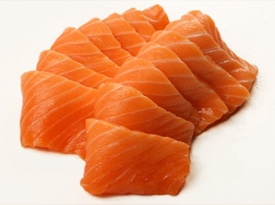How To Make Sashimi At Home

When most people think of “sushi” they picture the typical nigiri or make styles, however sashimi is an oft overlooked offering that is a wonderful choice for many reasons. High in protein, healthy fats (omega-3 fatty acids), nutrition, and low in carbs (perfect for those living a “keto” lifestyle). In Japanese, the word sashimi means “pierced body,” and there is some debate over the origin of the term which isn’t important. Sashimi is a great way to enjoy quality seafood. Without the rice, the true essence of the fish comes through. With just a dash of shoyu (soy sauce) to enhance it, It’s a purist’s dream. Some fish take very well to being served in this style, particularly the fattier cuts of tuna, toro, chu-toro, and o-toro. Live scallop (taken right out of the scallop shell) is, for example, an exquisite treat. It has a comparably different taste and texture than the scallop normally served as sushi. This item, and some like it, is always at its best served as sashimi.
The types of cuts
A sushi chef (itamae) will typically cut the fish into the thickness they deem appropriate for that variety of fish being served, in order to highlight the flavor and texture. The most common size cut is called hira-zukuri (meaning “flat slice”). This particular cut is usually about 10 mm (3/8 in) thick. Salmon, kingfish, and tuna are commonly cut in this style due to their flavor profile. The usu-zukuri type cut (meaning “thin slice”) is a thinner, diagonally cut slice that is often used to cut firmer fish such as flounder, bream, and whiting. The thinner slice lends to a better eating experience. This cut is typically 50 mm (2 in) long and 2 mm (1/16 in) wide. The kaku-zukuri style (meaning “square slice”) is cut into small cubes that are approximately 20 mm (3/4 in) on each side, which may be familiar to lovers of poke. The ito-zukuri style cut (meaning “thread slice”) is where the fish is cut into thin strips, less than 2 mm (1/16 in) in diameter. Squid is sometimes cut in the ito-zukuri style, also called ika sōmen (ika meaning “squid”) and then dipped in dashi (a very flavorful stock often used as the base for many different soups and broths in Japan) or men-tsuyu as one may eat somen noodles (spelling it in the traditional Western fashion).
Sourcing and preparing
Sashimi is actually the most simple style to make. Many Japanese markets have pre-shaped fillets ready for purchase. This is perfect for making sashimi at home because it means less work and less waste. Often, the fillets are approximately 1 1/2 to 2 inches wide and anywhere from 1/2 to 1 inch thick. The length varies, but they can be a few inches long to up to 6 (usually). If these are not available, try to trim your purchased fish into something along these lines. It doesn’t need to be perfect, and in fact, you can make sashimi just about any shape you want. The consistency and perfection sought in sushi restaurants is often for presentation. There are a few different cutting methods, as previously mentioned, and cutting against the grain is typically recommended. At home… It’s your food so do as you like, but it does make for a more tender cut.
To make sashimi, simply cut the fish against the grain into pieces approximately 1/4 of an inch thick, retaining the previous height and width proportions. The grain of the fish is usually readily apparent, so this should not be difficult. Generally speaking, the larger steakfish are well suited for sashimi as they are easily cut into the rectangles people expect to see on their plate. Smaller, lighter fish are harder to serve this way, however have sashimi-serving styles of their own. Ika (squid) for example is often scored and piled up folded over on itself when presented sashimi style on a plate. But again, eat what you like how you like it. Sashimi is often served with shiso and daikon as accompaniments. These are generally for aesthetic purposes, however I love to munch on the daikon with my meal.
If you are interested in finding a source of sushi grade seafood, we suggest our page on sushi grade fish and where one can purchase it may be helpful.